#fossil shell preservation
Explore tagged Tumblr posts
Photo

Harpoceras A-Grade Somerset Fossil Ammonite – Beacon Limestone, Jurassic, Ilminster, Somerset, UK
This listing showcases a striking Harpoceras fossil ammonite, A-grade quality, collected from the historic Beacon Limestone Formation near Ilminster, Somerset, UK. Harpoceras is a genus of extinct ammonites known for its elegantly ribbed, compressed shell and keeled whorls. These cephalopods thrived during the early Jurassic and are key indicators in Jurassic biostratigraphy.
Geological Unit: Beacon Limestone Formation
Geological Period: Jurassic
Stage: Toarcian (Late Early Jurassic)
Biozone: Harpoceras falciferum Zone (where applicable)
Depositional Environment: Marine shelf to offshore basin
Order: Ammonitida
Superfamily: Hildoceratoidea
Family: Hildoceratidae
This beautiful specimen was discovered by our experienced field collectors, Alister and Alison, on 13 May 2024. It has since been expertly cleaned, stabilised, and prepared by Alison to preserve its intricate morphological detail and to ensure long-term stability. The fossil is naturally embedded within its original matrix, offering a complete contextual snapshot of its Jurassic origin.
A scale cube (1cm) is included in the photographs for precise sizing—please refer to the image for full dimensions. The photo shown is of the exact specimen you will receive.
All of our Fossils are 100% Genuine Specimens & come with a Certificate of Authenticity.
This rare ammonite specimen makes a superb addition to any fossil collection and serves as a valuable educational piece for museums, geology enthusiasts, and palaeontology collectors alike.
#Harpoceras ammonite#Somerset fossil#Ilminster Jurassic fossil#Harpoceras Jurassic Coast#Beacon Limestone fossil#Jurassic ammonite UK#authentic fossil ammonite#ammonite collector's piece#fossil with certificate#Middle Jurassic ammonite#fossil shell preservation
0 notes
Text

Flynn likes to be involved with everything I do. If he sees me crouch down to look at something &/or pick it up, he likes to come & inspect it as well. In case it's interesting. Or edible. Or both.
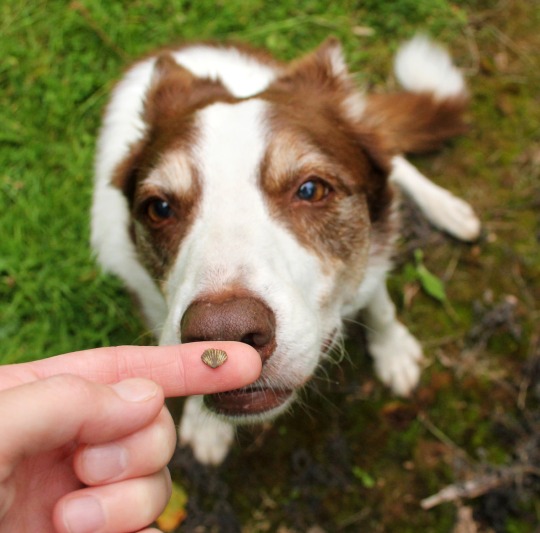
In this case, I'd found a fossil. According to Flynn this falls in the "Not Interesting" category but he gave it a polite sniff all the same. Like I politely praise him when he finds & shows me puddles & molehills. We humour each other.
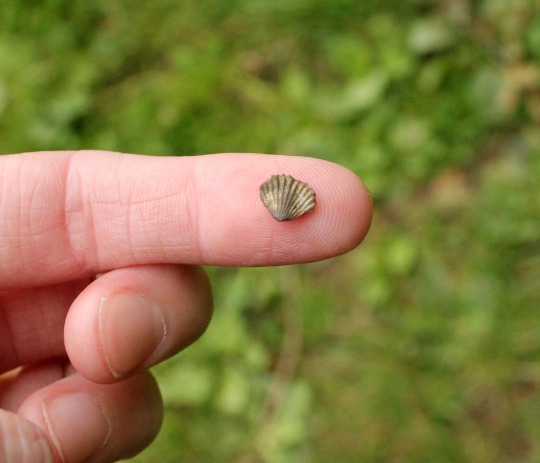
Such a teeny tiny fossil! It's one of the smallest I've found. Probably at least 420 million years old, which is just completely wild.
#I've got a fair sized collection of fossils now#mostly either brachiopods - which look like bi-valve molluscs but aren't... & corals#some of the shell fossils are very well preserved & almost look like they came off a beach that day!#I find them on farmland - ploughing turns the soil & they pop up to the surface. also there are 1 or 2 old quarries in the woods#this one was on the footpath - I bent down to pick up Flynn's toy & spotted it#silurian#fossil#shell#england#dog#flynn
227 notes
·
View notes
Text
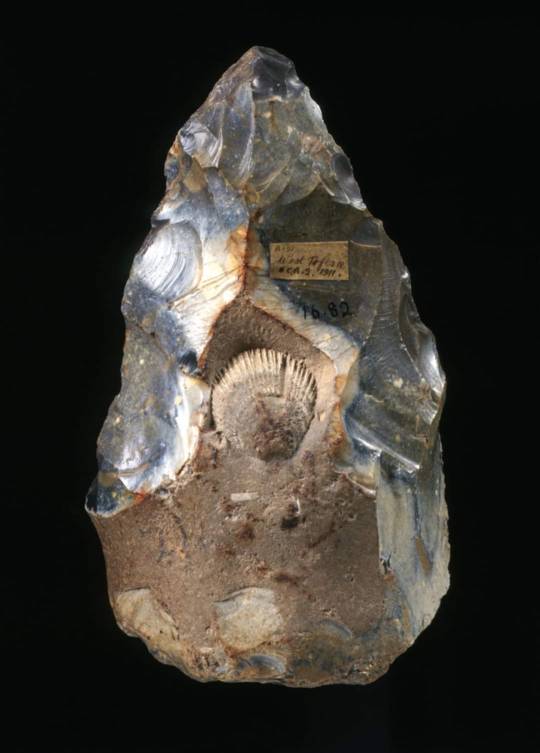
An extraordinary Acheulean handaxe knapped around a fossil shell circa 500,000-300,000 years ago.
The maker appears to have deliberately flaked around the shell to preserve and place it in a central position. As a result this handaxe has been described as an early example of artistic thought.
From West Tofts, Norfolk.
Museum of Archaeology and Anthropology, University of Cambridge, Courtesy Alison Fisk
25K notes
·
View notes
Text

A spectacularly preserved soft-shelled turtle and fish fossil - frozen in time 50 million years ago From Green River
Photo by: Field Museum /Chicago
407 notes
·
View notes
Text

Panochthus tuberculatus was a large glyptodont – a group of giant heavily-armored armadillos – that lived in central and southern South America during the late Pleistocene, about 800,000-12,000 years ago.
Around 3.5m long (~11.5') and 1.5m tall (~5'), it was similar in size to a modern rhino (or a small car), and its large domed "shell" made up of numerous small bony osteoderms made it resemble a mammalian tortoise. Its skull was short and deep, with ever-growing grinding teeth and downwards-flaring cheekbones that anchored powerful jaw muscles. A preserved hyoid apparatus indicates that Panochthus also had a more flexible tongue than some other glyptodonts.
The base of its tail was segmented into rings that allowed it to flex, while the end of the tail was fused into a solid bony tube that was probably studded with large keratinous knobs or spikes.
While these sort of tail weapons in glyptodonts have been proposed as being anti-predator defenses, biomechanical studies suggest they required precise aiming to be most effective and weren't well-suited to fending off fast-moving attackers. Instead they may have been more specialized for fighting each other in ritualized forms of combat – an idea supported by injuries in fossil carapaces that appear to have been caused by blows from opponents' tail clubs.
———
NixIllustration.com | Tumblr | Patreon
References:
Blanco, R. Ernesto, Washington W. Jones, and Andrés Rinderknecht. "The sweet spot of a biological hammer: the centre of percussion of glyptodont (Mammalia: Xenarthra) tail clubs" Proc. R. Soc. B. 276 (2009): 3971–3978. https://www.academia.edu/download/71293979/The_sweet_spot_of_a_biological_hammer_th20211004-20926-1xg5uwp.pdf
Luna, Carlos A., et al. "Memories of the blows: severe soft-tissue injuries in caudal vertebrae of Panochthus Burmeister (Xenarthra, Glyptodontidae)." Journal of Mammalian Evolution 31.3 (2024): 29. https://doi.org/10.1007/s10914-024-09729-0
Lima, F.C.G., Porpino, K. & Ribeiro, A.M. "Trauma-induced alterations in the exoskeleton of glyptodonts (Cingulata, Xenarthra) associated with fighting behavior." Journal of Mammalian Evolution 32, 9 (2025). https://doi.org/10.1007/s10914-025-09750-x
Wikipedia contributors. “Glyptodont” Wikipedia, 25 May 2025, https://en.wikipedia.org/wiki/Glyptodont
Wikipedia contributors. “Panochthus” Wikipedia, 02 Jun. 2025, https://en.wikipedia.org/wiki/Panochthus
Zamorano, Martín, and Richard A. Fariña. "Changes in form and function of the caudal tubes in Panochthus (Xenarthra; Glyptodontidae) along the Pleistocene." Historical Biology 34.12 (2022): 2265-2272. https://www.researchgate.net/publication/357020158_Changes_in_form_and_function_of_the_caudal_tubes_in_Panochthus_Xenarthra_Glyptodontidae_along_the_Pleistocene
Zamorano, Martín, et al. "Hyoid apparatus of Panochthus sp. (Xenarthra; Glyptodontidae) from the Late Pleistocene of the Pampean Region (Argentina). Comparative description and muscle reconstruction." (2018). Neues Jahrbuch für Geologie und Paläontologie - Abhandlungen 288.2 (2018): 205–219. https://ri.conicet.gov.ar/bitstream/handle/11336/97007/CONICET_Digital_Nro.bcac99f6-b327-435a-bca7-137dfd6af700_D.pdf?sequence=5
#science illustration#paleontology#paleoart#palaeoblr#panochthus#glyptodont#glyptodontinae#chlamyphoridae#cingulata#armadillo#xenarthra#mammal#art
258 notes
·
View notes
Text

It’s Trilobite Tuesday! Fossilized trilobites have been found in an array of colors. This tonal variation is mostly due to the presence of specific minerals, which can replace the trilobite’s calcite shell over the course of hundreds of millions of years. Those minerals replace the trilobite's original shell in a wide range of colors including shades of black, brown, red, orange, and yellow... such as this strikingly preserved Wenndorfia from the Devonian of Morocco.
#science#amnh#museum#fossil#nature#natural history#animals#fact of the day#did you know#paleontology#trilobite#trilobite tuesday#devonian#morocco#stem
406 notes
·
View notes
Text
thinking abt mumbo's past few seasons and how each corresponds to different representations of consciousness, separate from each other
season 7: the heart; a frankenstein of nature and machinery, kept alive more by the love of those around you than your own actions.
season 8: the soul; intertwined with yourself and those around you. if the soul inhabiting someone changes, is it still the same person? is it still the same soul?
season 9: the body; implying something held within, but somewhat of an empty shell by itself. a ghost, a fossil, a picture frozen in time.
season 10: the mind; a mirror to the others, but warped with static. it will preserve its memories, but they'll be slightly different with each iteration.
#im so normal about this btw#the part abt s8 is less focused on his base but i do also think his starter and mega bases fit!#in the sense of things you choose to identify with making up your soul (his van & his mega base being inspired by his partners country)#i only went back to s7 bc thats when i started watching srry </3#mumbo jumbo#hermitcraft mumbo#hermitcraft#hermitblr
253 notes
·
View notes
Text
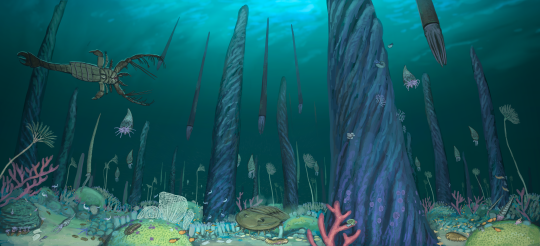
Here the result of the last formation stream of 2024. Over the course of 6 hours we explored the many organisms that inhabited the reefs of the Whitewater formation.
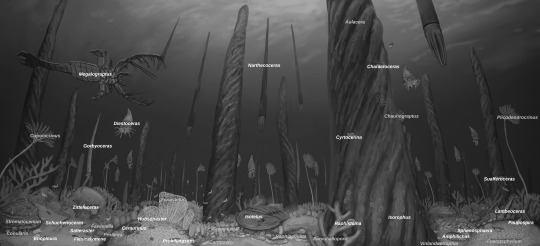
This formation preserves a rich benthic community with many sessile animals. Towering above all were the giant columnar sponges of the genus Aulacers, up to 3 m tall Ordovician skyscrapers. Between them hovered cephalopods and swam the eurypterid Megalopraptus.

Most organisms from here wer small, just a few centimeters, which is why Discord member JW made a second size chart just to bring across how the largest animals, Megalograptus and the giant trilobite Isotelus, compared to the rest.
I think something that is often overlooked in discussions about these formations is the animals we don't have. There are no crustaceans here, no jellyfish, although they probably still made up a significant part of the biomass. These animals are simply not preserved which makes our image of the Whitewater formation incomplete and biased towards the hard shelled organism. As a paleoartist one is constantly reminded of such gaps, we have to decide how much we want to speculate or borrow from other localities, or if we want to stick strictly to the fossil record.
In these formation pieces I usually do the latter but I'm painfully aware how much I miss in each piece.
Btw. since this is the last formation piece of the year I would love to hear which one was your favorite?!
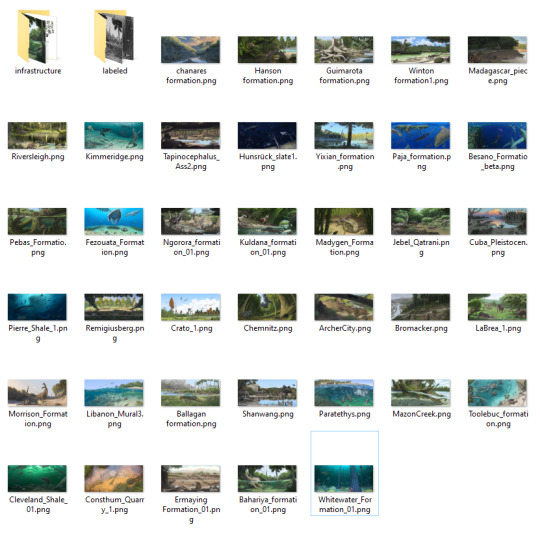
252 notes
·
View notes
Note
Okay I have to ask how Shane reacts when he realizes he's friends (or... maybe that he caught feelings for him? *eyes*) with Hunter because I've been laughing to myself about their golden retriever/black cat relationship all day. Love your work, I'm so thrilled I came across your blog!
i'm so glad u like my sillies this makes me so happy ACK!!!! (also heads up b4 u look at the rest of the post..... it's long as hell i'm sorry 😞 my yap switch flipped on...)
i think shane would realize he actually cares about hunter when something's off like. hunter hasn't come by the saloon in several days and shane KNOWS he disappears sometimes doing god knows what (shane thought bubble -> *hes probably off doing nerd shit as usual.........but given his tendency to throw himself into absolute danger with zero self preservation he could be dying in a ditch right now..... shit what do i do. wait why the hell do i care? ...but is anyone else going to check on him? ..... probably not. ugh. okay fine i'll go look for him. but if he's just holing himself up over some shell and worrying people for no reason i'm going to be so pissed off*) then he grumbles the entire way over to hunter's run-down cabin and tries really hard not to think about how he might actually Care about and Be Worried about hunter (feelings ugh amirite.... #emo)
shane makes it to hunter's cabin and sees that the lights r on. he knocks and hears nothing for like 5 seconds until hunter yells from inside that shane can let himself in. first thought: *he usually opens the door with an unnecessarily energetic greeting but he's not doing that now..... okay weird. maybe he just doesn't wanna get up from his desk or something. whatever.* he enters and sees hunter on the ground in the middle of wrapping a Massive Fucking Gash on his leg with gauze (he accidentally re-opened his wounds by exerting his body when its already injured u__u) and there's blood dripping everywhere and shane looks at him like this:
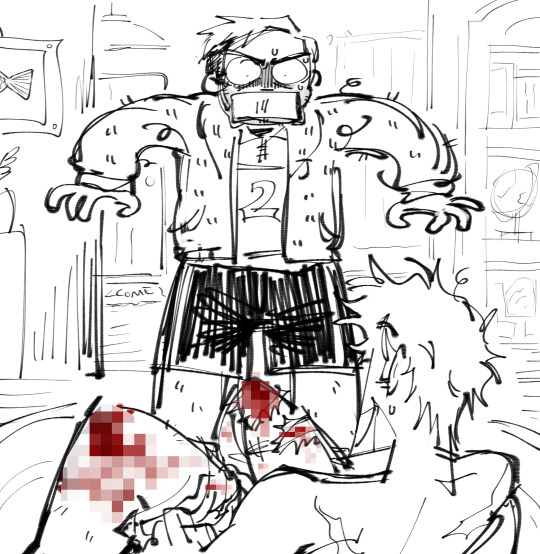
shane freaks out and yells at hunter when he tells him he went out to the skull cavern when he was already injured and that he wasn't coming to the saloon cuz he didn't wanna over-exert his leg but he just HAD to go after learning this specific fossil could be found in the skull cavern!!!!!
since this is the first real big offense shane helps hunter treat his reopened wounds and tells him not to do dumb shit like that again and to just "go fucking see harvey tomorrow jesus christ." hunter sees shane's hands shaking but he doesn't really get why so he keeps it to himself.
stuff like this happens again and i think at a certain point shane gets really angry at hunter bc of the constant lack of self-preservation and getting hurt. and he blows up on hunter like "do you not even think for a SECOND when you throw yourself into this–this shit how cruel it is to other people who worry about you? why the FUCK do you keep doing this???" and hunter gets defensive both cuz he feels attacked and also cuz he's angry shane called his interest 'shit' and he's like. "well you of all people shouldn't be saying that." and that strikes a nerve n shane is about to yell back but he stops balls his fists tight n walks out
this point of conflict btwn them is interesting cuz the reason why shane gets angry at hunter's lack of self-preservation that worries everyone around him isn't just that he's experienced grief with the death of loved ones before (jas's parents) + understands how traumatic it can be, but also cuz he's projecting the frustration he has towards himself onto hunter. he can see similar patterns of perpetuating self-harming habits in hunter like he does with himself
after big blowup fight i think they sit next to each other at the dock on the big pond together staring at the moon reflecting off the water in silence. then hunter breaks it by saying ".....i didn't have anyone.. um." (stares at the ripples forming in the lake) "...there was no one who ever said anything when i.. did things like this.. well, injure myself. i suppose." (shane turns to look at hunter who is Still looking at the water. he is looking at the water and not on shane On Purpose.) "i guessed it never was important enough to dignify with.. anything. so i've just carried on like this. i thought i was bothered by what you said because you were being hypocritical.... but i think i was jealous of you." and shane scoffs at that like "hah. what is there to even be jealous of." and hunter's like: "...........jas." which throws shane off. hes like, "..jas??" then hunter goes: "..and marnie. who worry for you." then shane goes silent at that for a bit.
i think this is where shane's image of hunter as this sort of shallow self-confident buccaneering guy starts to break down... that this guy who he envies for having a passion he's held onto his entire life also experiences some similar form of feeling like he has no self worth. and that hunter, unlike himself, doesn't feel like every time he harms himself he's letting people down because he doesn't believe there are people to let down in the first place. (required context: hunter was an orphan who cycled through many foster homes where he was mostly neglected, or his guardians didn't put much effort into developing a relationship with him b/c they either didn't have the bandwidth to or couldn't understand how to bond with a neurodivergent kid. he mostly put his all into studying his interests over everything else, and when pursuing higher education he largely kept to himself + his studies and only had perfunctory interactions/acquaintanceships/academic relationships with other people. he participated in research and maintained academic/work relationships with colleagues and came to pelican town to further his own personal research)
i don't have this dialogue/scene fully fleshed out or written cuz i am just writing this shit on the go LMAO but here is a TLDR except it's not really a TLDR cuz it's long as hell:
hunter's problem: believes there's no one to actually care about him/"let down" because he is inherently unlovable and thus is incapable of love because he was never able to reciprocate any kind of 'love' in the first place. so he fixated everything on his interest and disregarded 'himself'
shane's problem: doesn't believe he's important enough/has any inherent worth b/c he has no passion or potential (b/c 'its too late and i've squandered my time alive just to amount to nothing) or nothing he thinks he can 'contribute' to the world (WRONG!!!!! ITS LOVE!!!!!!!). feels extreme guilt that he is alive instead of jas's parents (who he believes had 'worth') and feels guilty over the fact that his only reason to keep living is jas. he thinks he's selfish for wanting to die when jas needs him and doesn't think jas deserves to have to deal with/be raised by someone like him
shane concludes that no matter what he does he's going to fail because he's worthless and has nothing to contribute to the world. and vice versa. it's a mutually reinforcing hole that he can't dig himself out of. and he beats himself up for not being 'strong enough to dig himself out' when depression and trauma as a result of grief of the death of loved ones and addictive habits as unhealthy coping mechanisms are things that some people just can't get out of on their own. and that sometimes help is necessary.
they will not talk about all of this in one conversation obviously because they are not efficient or good at talking about their feelings enough 😭 but hey they'll get there..... after Many Conversations over an Extended Period of Time. but when they get there:
shane @ hunter: "you have someone who cares about you and that's me. you are not incapable of love and human connection just because you have never been given the love that everyone deserves"
hunter @ shane: "you don't need to 'contribute' this arbitrary 'something' to the world to be 'worth' something, your inherent capacity for love itself is reason enough for your existence"
who knows.... maybe they'll even kiss.....! woah! after they take 989846463412347 years to hold hands. i actually think shane would be the bigger initiator of romantic gestures (at least @ first) because unlike him hunter has no frame of reference for any kind of love. Especially romance. well it's not like shane is much better tbh. they'll both get better at it!!!!!!!!!! hooray!!!!!!!!!!!

#cw blood#my art#eon babbles#ask#excavator hunter#long post#stardew valley#sdv#stardew valley oc#stardew valley fanart#sdv oc#sdv fanart#shane sdv#stardew shane#sdv shane#stardew valley shane#stardew#stardew fanart
55 notes
·
View notes
Text
Sedimental Value
Megatron vs. Paleontology
I just wanted to yap about fossils lmao and pun.
Part 1/4 Link
---
The battle had been fierce—briefly.
Optimus and Megatron had traded blows across the rocky slopes, scattering wildlife and triggering small landslides somewhere in the Appalachian Mountains.
“For once,” Megatron growled, “stay down, Prime!”
Optimus Prime landed with a heavy thud, shaking pine needles loose from the trees. Megatron followed, crashing through the canopy, fusion cannon flaring.
“This ends now, Prime!” Megatron snarled, charging with wild force.
Optimus sidestepped just in time.
CRUNCH .
Megatron pitched forward with a mechanical yelp as his foot caught something buried in the dirt. He tripped in glorious, undignified fashion and landed face-first into a rocky embankment.
CRACK. “GRAAAUGH!”
One clumsy misstep, one badly-placed foot, and the Warlord of Kaon was suddenly flailing—arms windmilling—before crashing into the side of a shale outcrop.
A boulder split in half.
Megatron lay there for a moment in stunned silence, then shoved himself upright with a snarl. “What in the pit—?!”
He looked down, half-expecting a landmine or a hidden Autobot trap.
Instead, he saw... a rock.
Optimus skidded to a halt, mid-leap. “...Are you alright?”
Megatron roared and shoved himself up. “WHO PUT THIS RIDICULOUS... LUMP OF ROCK IN MY PATH?!”
Optimus stepped over calmly, peering at the object Megatron had tripped on. Embedded in the earth was a large, spiral-shaped fossil.
The Prime paused mid-charge, optics flicking from Megatron to the object. Then his expression changed.
“Oh—oh, no way.” He stepped forward quickly, crouching beside the half-buried stone. “Is that a fossil?”
Megatron blinked. “A what?”
Optimus’s entire demeanor shifted, tension evaporating like mist in sunlight. “It’s a Brachiopod. Look at this—still partially embedded, but you can make out the hinge and the ridges across the shell. Perfect symmetry.” He brushed away some soil with careful fingers. “And the preservation? It’s Devonian. Has to be. This entire region used to be seabed over 400 million Earth years ago.”
Megatron blinked. “Prime. We are in the middle of a battle.”
Optimus continued excitedly monologuing.
Megatron just stared.
Optimus was... smiling.
His voice had gone light and enthusiastic, the way it never did during war. There was something unguarded in him—something Megatron hadn’t seen in millennia.
“You're monologuing about sea bugs,” Megatron said flatly.
But Optimus wasn’t listening anymore.
“This one likely lived anchored to the ocean floor, filtering particles from the water. And here it is—untouched for eons, until you stepped on it.” He chuckled softly. “Poor thing.”
Megatron grumbled and leaned on a nearby tree, rubbing his helm. “This was supposed to be a combat operation.”
Optimus didn’t even glance up. “Do you remember when I used to do this full-time? Study, document, preserve? I spent megacycles in the Hall of Records, cataloging ancient systems, reading about long-dead civilizations. Back then, nothing was more important to me than understanding the past.”
Megatron didn’t answer. Not right away.
But he did remember.
He remembered a younger Optimus—Orion Pax then—hovering over datacores and relics with the same reverence he now gave the little fossil. Megatron had walked those archives once, long before revolution burned away what they’d been. He’d argued with Orion about injustice and philosophy in the low-lit vaults beneath Iacon. They’d fought then too—verbally, eloquently. Earnestly.
“You were different then,” Megatron muttered, his voice low.
Optimus finally looked up.
“You talked about knowledge like it was sacred,” Megatron continued. “You wanted to build something with it. Something with me. Not—" he gestured vaguely at the broken trees and scorched earth, “—this.”
Optimus’s gaze softened. “I never stopped wanting that, Megatron.”
“I know.” He looked away. “That was the tragedy, wasn’t it?”
For a long moment, neither of them moved. The wind whispered through the trees, stirring branches and memories alike.
Optimus turned back to the fossil. “Do you ever miss it?”
“What?”
“The people we were before war turned us into this.”
“…Sometimes,” Megatron admitted. “But then I remember who I was forced to become.”
Silence again. Not tense—just... quiet.
Optimus stood and gently set the fossil back in the dirt, carefully packing soil around it.
“You’re preserving it?” Megatron asked incredulously.
“Of course. Some things are worth protecting.”
Megatron huffed. “You’ll never change.”
“Maybe not,” Optimus said. “But I still remember how to value something ancient and fragile.”
Megatron stared at him. “You’re talking about the rock, aren’t you?”
Optimus smiled faintly. “Mostly.”
Megatron shook his head, a reluctant smirk twitching at the corner of his mouth.
“You’re lucky I tripped on that thing,” he said. “Any longer and I might’ve hit you hard enough to shut you up.”
“You could try,” Optimus replied, tone amused. “But I’d probably start quoting paleontology terms while half delirious anyway.”
Megatron groaned. “I hate that I missed this part of you.”
Optimus tilted his head. “You didn’t miss it. It was always there. You just stopped listening.”
Megatron shook his head, rising. “I’m leaving before you start talking about trilobites.”
“I do love trilobites,” Optimus called after him as Megatron transformed and blasted off.
“You’re unbearable,” he called as he lifted off. “Tell your fossil goodbye for me.”
“I will,” Optimus said softly, watching him disappear into the sky.
He turned back to the ridge, brushing his hand once more over the ancient shell, then sat down beside it.
And for a while, he simply watched the wind move through the trees.
#ao3#fanfic#The inner archivist is a history buff#optimus prime#optimus x megatron#transformers optimus#Optimus prime#optimus#opmeg#megop#transformers#transformers fanfiction#megatron x optimus prime#megatron#tf megatron#transformers megatron#transformers megop#transformers opmeg
59 notes
·
View notes
Photo

Harpoceras A-Grade Somerset Fossil Ammonite – Beacon Limestone, Jurassic, Ilminster, Somerset, UK
This listing showcases a striking Harpoceras fossil ammonite, A-grade quality, collected from the historic Beacon Limestone Formation near Ilminster, Somerset, UK. Harpoceras is a genus of extinct ammonites known for its elegantly ribbed, compressed shell and keeled whorls. These cephalopods thrived during the early Jurassic and are key indicators in Jurassic biostratigraphy.
Geological Unit: Beacon Limestone Formation
Geological Period: Jurassic
Stage: Toarcian (Late Early Jurassic)
Biozone: Harpoceras falciferum Zone (where applicable)
Depositional Environment: Marine shelf to offshore basin
Order: Ammonitida
Superfamily: Hildoceratoidea
Family: Hildoceratidae
This beautiful specimen was discovered by our experienced field collectors, Alister and Alison, on 13 May 2024. It has since been expertly cleaned, stabilised, and prepared by Alison to preserve its intricate morphological detail and to ensure long-term stability. The fossil is naturally embedded within its original matrix, offering a complete contextual snapshot of its Jurassic origin.
A scale cube (1cm) is included in the photographs for precise sizing—please refer to the image for full dimensions. The photo shown is of the exact specimen you will receive.
All of our Fossils are 100% Genuine Specimens & come with a Certificate of Authenticity.
This rare ammonite specimen makes a superb addition to any fossil collection and serves as a valuable educational piece for museums, geology enthusiasts, and palaeontology collectors alike.
#Harpoceras ammonite#Somerset fossil#Ilminster Jurassic fossil#Harpoceras Jurassic Coast#Beacon Limestone fossil#Jurassic ammonite UK#authentic fossil ammonite#ammonite collector's piece#fossil with certificate#Middle Jurassic ammonite#fossil shell preservation
0 notes
Text

Tiny curio collection pendants! I try to put as many interesting tiny things in each of these as possible, so if you like tiny things you've come to the right place
Possible contents include: fossils, tiny bones, opal chips, emu eggshell pieces, preserved seaweed, sea urchin spines, barnacle feeding feelers shells, 17 year cicada wings shell legs or claws, jewel beetle shell pieces, coral pieces, ancient Egyptian beads, gears, and more!
These will be available first at the Detroit oddities expo July 13-14 (2024 in case you're reading this in the future) but I'll list them online after that. I also messed up half the batch (not pictured) so if you're interested in a "second" at a discount let me know (the glue wasn't completely dry between the resin layers before the second pour so some items have a milky-looking aura.)
#miniature#curio collection#oddities and curiosities#oddities#vulture culture#tiny things#goblincore#crowcore#natural history#mini museum#cabinet of curiosities#curio#my art#resin jewelry
302 notes
·
View notes
Text
Round 3 - Reptilia - Gruiformes


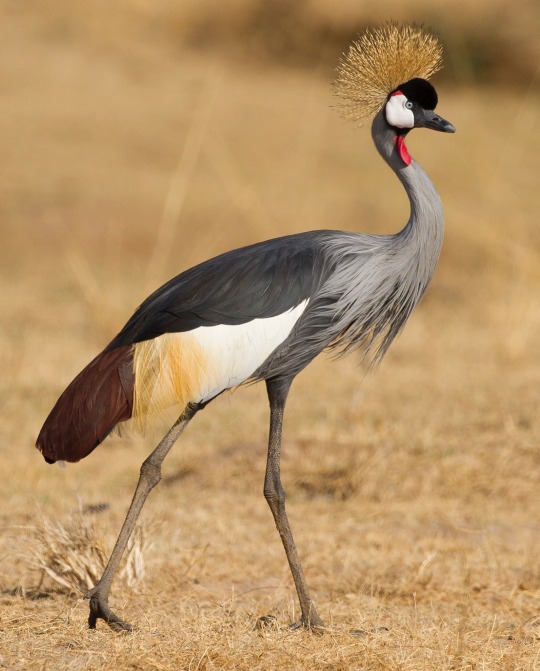

(Sources - 1, 2, 3, 4)
Our next order of birds are the Gruiformes, a diverse order with a widespread geographical diversity. “Gruiform” means “crane-like”, even though the majority of gruiformes are rails. Gruiformes contains the families Psophiidae (“trumpeters”), Aramidae (“Limpkin”), Gruidae (“cranes”), Rallidae (“rails”, “coots”, and “crakes”), Heliornithidae (“finfoots”), and Sarothruridae (“flufftails”).
Gruiformes are terrestrial or wading birds with a considerable amount of diversity. The Trumpeters (genus Psophia) (image 1) are rotund birds with long, flexible necks and legs, downward-curving bills, soft plumage, large eyes, and a “hunched” appearance. They are weak fliers but fast runners, and can also swim across rivers. The cranes (Gruidae) (image 3 and gif below) and the Limpkin (Aramus guarauna) are long-necked, long-legged, long-beaked waders, some of which are the world’s tallest flying birds. Their plumage varies by habitat. The Rallidae (image 4) are the most diverse family of Gruiformes. Many are associated with wetland habitats, some being semi-aquatic like waterfowl (such as the coot), and some being more like wading birds or shorebirds. The finfoots (Heliornithidae) resemble rails; they have long necks, slender bodies, broad tails, and sharp, pointed bills. Their legs and feet are brightly coloured and they are capable of walking well and even moving quickly on land. The flufftails (Sarothruridae) (image 2) are small- to medium-sized ground-living birds. Due to the diversity of this order, it is difficult to summarize them further!
Gruiformes evolved in the Paleocene, around 60 million years ago.
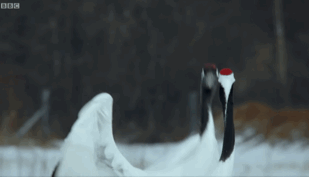
(source)
Propaganda under the cut:
Grey-winged Trumpeters (Psophia crepitans) are polyandrous and cooperative breeders. Up to three males mate with the dominant female of the flock, and all members of the flock contribute to raising the young.
One of the handful of non-avian dinosaurs we know the colors of is the Late Jurassic Caihong juji. Thanks to some exquisitely fossilized melanosomes (pigment cells) within the animals feathers, paleontologists were able to determine Caihong’s coloration by comparing it to those of living birds. The sheets of platelet-like melanosomes were solid and lacked air bubbles, and were thus most similar to the iridescent feathers that exist in modern Trumpeters (genus Psophia). It is thanks to trumpeters for preserving this type of melanosome, that we know the appearance of a dinosaur from the Late Jurassic!
The Limpkin (Aramus guarauna) has a beak that is slightly open near the end, giving it a tweezer-like action to remove their main prey, Apple Snails (family Ampullariidae), from their shells. In many individuals the tip of their beak curves slightly to the right, matching the Apple Snails’ shells.
Most species of cranes have been affected by human activities and are at the least classified as threatened, if not critically endangered. The plight of the Whooping Crane (Grus americana) of North America inspired some of the first US legislation to protect endangered species. After being pushed to the brink of extinction due to unregulated hunting and loss of habitat, just 21 wild (and two captive) Whooping Cranes remained by 1941. Thanks to conservation efforts, the total number of cranes in the surviving migratory population, including those in captivity, only slightly exceeds 911 birds as of 2020.
The Sanskrit epic poet Valmiki was inspired to write the first śloka couplet by the pathos of seeing a male Sarus Crane (Antigone antigone) shot while dancing with its mate.
The endangered South Island Takahē (Porphyrio hochstetteri) is a flightless swamphen indigenous to New Zealand. Takahē were hunted extensively by both early European settlers and Māori, and takahē's bones, as well as fossil remains, have been found in middens in the South Island. They were not named and described by Europeans until 1847, and then only from fossil bones. In 1850 a living bird was captured, and three more collected in the 19th century. After another bird was captured in 1898, and no more were to be found, the species was presumed extinct. Fifty years later, however, after a carefully planned search, South Island Takahē were dramatically rediscovered in November 1948 by Geoffrey Orbell in an isolated valley in the South Island's Murchison Mountains. Since then, takahē have been reintroduced to numerous locations across the country. As of 2023, the population is around 500 and is growing by 8% per year.
The Guam Rail (Hypotaenidia owstoni) came perilously close to extinction when Brown Tree Snakes (Boiga irregularis) were introduced to Guam, but some of the last remaining individuals were taken into captivity and have been breeding well. They have since been successfully introduced to the nearby Rota and Cocos islands, as the Brown Tree Snakes have yet to be eradicated in Guam. In 2019, the Guam Rail became the second bird species to be reclassified by the International Union for the Conservation of Nature from Extinct in the Wild, to Critically Endangered.
#sorry if there are any mistakes here and if it’s a bit short#it’s midnight and I’m fighting sleep to finish this#animal polls#round 3#reptilia#Gruiformes
83 notes
·
View notes
Text
Most animals and plants never fossilize. For those that do, it's usually only hard parts such as bones and shells that preserve. However, in some exceptional cases, soft tissues such as muscles and gills survive the fossilization process and can present a wealth of information about the biology and ecology of ancient organisms. In a paper recently published in Palaeontologia Electronica, Dr. Adiel Klompmaker, University of Alabama Museums' curator of paleontology, and colleagues reported on a remarkable crab with multiple mineralized soft tissues preserved. This crab lived 75 million years ago during the Cretaceous in the area of present-day South Dakota in an ancient sea known as the Western Interior Seaway.
Continue Reading.
403 notes
·
View notes
Text
Eocene gators and Miocene gharials
It's been a busy two-ish weeks for me once again with two "new" crocodilians dropping not even a week apart. These two newcommers couldn't be any more different, as you'll see soon enough.
The first of the two is not exactly a stranger, in more than one way. Sutekhsuchus dowsoni in truth has been known since 1920, when it was described as Tomistoma dowsoni based on fossils from Wadi Moghra in Egypt. Tomistoma being one of those genera that was a popular wastebasket for crocs. Broad snout and overbite? Alligator. Narrow snout? Tomistoma. Everything else? Crocodylus.
Tomistoma is still heavily affected by that, with the paper still referencing about half a dozen species of Tomistoma that are almost definitely not Tomistoma. In that regard, tho its not super new its fantastic to see that one of these Miocene circum-mediterranean forms finally gets its due (especially after having been unceremoniously been lumped into T. lusitanica for a while). Additional fun fact, the original "missinterpretation" as a species of Tomistoma is used as the basis for the new name, basically meaning "Set's crocodile" in reference to Sutekh/Set being god of deception.
Left: Sutekhsuchus by @paleomiguel Right: Sutekhsuchus by @manusuchus Go give them a follow


Another way in which Sutekhsuchus is not "new new" is that, intentional or not, the name was actually dropped a month ago without many people noticing. As has been pointed out to me by @paleomiguel, a recent paper on Eogavialis featured a phylogeny that contained Sutekhsuchus, a name I was not familiar with. However, the species name did ring a bell and after a brief search on google scholar I did find a reference to the then unpublished redescription.
Anyways, background aside Sutekhsuchus has some cool stuff going for it. Its anatomy is in some regards intermediate between the modern false gharial (which the paper regards as one of the basalmost gavialoids) and the Indian gharial (a highly derived weirdo). Ultimately, its just one of several species that lived around the broader Tethys Sea during the Miocene as part of a flourishing croc ecosystem. Given the warmer temperatures, it was in pretty good company. We know it from Gebel Zelten and Wadi Moghra, both of which preserve the bones of the robust Rimasuchus and the bizarre Euthecodon, both members of the Osteolaemines ("dwarf crocodiles", a name that makes more sense when you ignore these fossil forms). Both localities are interpreted as being somewhat coastal, consisting of lagoons, estuaries, slow moving rivers and surrounding forests.
Left: Rimasuchus attacking Zygolophodon by Michael Tripoli Right: Euthecodon arambourgi by yours truly


The other new crocodilian was much more of a surprise to me personally. Ahdeskatanka russlanddeutsche is a species of basal alligatorine from the Eocene of North Dakota. The genus name derives from the Dakota word for alligator, the species name references ethnic Germans that settled the region after emmigrating from the Russian Empire.
Ahdeskatanka via Cossette & Tarailo

It lived during the early Eocene in the Golden Valley Formation of North Dakota and in many regards resembles many early alligators of the time, having been small with a short and blunt snout and globular teeth well suited for crushing hard shelled prey.
During this time period North Dakota experienced the Early Eocene Climatic Optimum, an exceptional warm period that saw lush subtropical to tropical forests grow along the banks of meandering rivers and extensive swamps. Not great for mammalian carnivores but fantastic for crocodilians, of which there were plenty. The Golden Valley was home to at least 4. In addition to Ahdeskatanka there was a similar, possibly closely related unnamed form, a large crocodyloid similar to the ubiquitous Borealosuchus and the large caiman Chrysochampsa, a relic of a Cretaceous offshoot of the family.
Left: Borealosuchus by Wayne Hsieh Right: Chrysochampsa via Cossette & Tarailo


As always, here the respective Wikipedia pages and relevant publications
Sutekhsuchus: https://en.m.wikipedia.org/wiki/Sutekhsuchus https://www.tandfonline.com/doi/full/10.1080/14772019.2024.2384548
Ahdeskatanka: https://en.m.wikipedia.org/wiki/Ahdeskatanka https://www.tandfonline.com/doi/full/10.1080/02724634.2024.2403579
#Sutekhsuchus#Ahdesktatanka#Tomistoma dowsoni#Wadi moghra#Gebel zelten#Golden valley formation#Prehistory#eocene#Miocene#croc#crocodilia#Alligatoridae#Gavialidae#Palaeoblr#paleontology#prehistory#cenozoic
95 notes
·
View notes
Text

The distinctive pinhole eyes, leathery hood, and numerous tentacles of modern nautiluses were traditionally thought to represent the "primitive" ancestral state of early shelled cephalopods – but genetic studies have found that that nautiluses actually secondarily lost the genes for building lensed eyes, and their embryological development shows the initial formation of ten arm buds (similar to those of coeloids) with their hood appearing to be created via fusing some of the many tentacles that form later.
There's a Cretaceous nautilidan fossil that preserves soft tissue impressions of what appear to be pinhole eyes and possibly a remnant of a hood, so we know these modern-style nautilus features were well-established by the late Mesozoic. But for much more ancient Paleozoic members of the lineage… we can potentially get more speculative.
So, here's an example reconstructed with un-nautilus-like soft parts.
Solenochilus springeri was a nautilidan that lived during the Late Carboniferous, around 320 million years ago, in shallow tropical marine waters covering what is now Arkansas, USA.
Up to about 20cm in diameter, (~8"), its shell featured long sideways spines which may have served as a defense against predators – or possibly as a display feature since they only developed upon reaching maturity.
———
NixIllustration.com | Tumblr | Patreon
References:
Anthony, Franz. "500 million years of cephalopod fossils" Earth Archives, 19 Feb. 2018, https://eartharchives.org/articles/500-million-years-of-cephalopod-fossils/index.html
Klug, Christian, et al. "Preservation of nautilid soft parts inside and outside the conch interpreted as central nervous system, eyes, and renal concrements from the Lebanese Cenomanian." Swiss Journal of Palaeontology 140 (2021): 1-11. https://doi.org/10.1186/s13358-021-00229-9
Korn, Dieter, and Christian Klug. "Early Carboniferous coiled nautiloids from the Anti-Atlas (Morocco)." European Journal of Taxonomy 885 (2023): 156-194. https://doi.org/10.5852/ejt.2023.885.2199
Kröger, Björn, Jakob Vinther, and Dirk Fuchs. "Cephalopod origin and evolution: a congruent picture emerging from fossils, development and molecules: extant cephalopods are younger than previously realised and were under major selection to become agile, shell‐less predators." BioEssays 33.8 (2011): 602-613. https://doi.org/10.1002/bies.201100001
Mikesh, David L., and Brian F. Glenister. "Solenochilus Springeri (White & St. John, 1868) from the Pennsylvanian of Southern Iowa." Proceedings of the Iowa Academy of Science. Vol. 73. No. 1. 1966. https://scholarworks.uni.edu/pias/vol73/iss1/39/
Shchedukhin, A. Yu. "New Species of the Genus Acanthonautilus (Solenochilidae, Nautilida) from the Early Permian Shakhtau Reef (Cis-Urals)." Paleontological Journal 58.5 (2024): 506-515. https://www.researchgate.net/publication/384922837_New_Species_of_the_Genus_Acanthonautilus_Solenochilidae_Nautilida_from_the_Early_Permian_Shakhtau_Reef_Cis-Urals
Wikipedia contributors. “Nautilida” Wikipedia, 26 Nov. 2024, https://en.wikipedia.org/wiki/Nautilida
Wikipedia contributors. “Solenochilus” Wikipedia, 28 Apr. 2022, https://en.wikipedia.org/wiki/Solenochilus
#science illustration#paleontology#paleoart#palaeoblr#solenochilus#solenochilidae#nautilida#nautiloid#cephalopod#mollusc#invertebrate#art#doing the inverse of all those ammonite reconstructions that make them look like nautiluses
220 notes
·
View notes